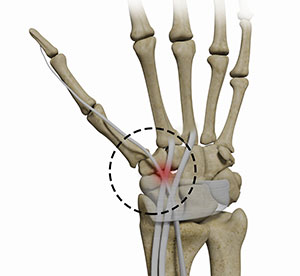
What is Distal Intersection Syndrome?
Distal intersection syndrome also referred to as tenosynovitis of the radial wrist extensors is characterized by the radial wrist and forearm pain. Distal intersection syndrome is tenosynovitis of the third extensor compartment (extensor pollicis longus) where it crosses the second extensor compartment. It is different from intersection syndrome which is overuse tenosynovitis particularly of the second extensor compartment (extensor carpi radialis longus and extensor carpi radialis brevis) caused due to friction from the overlying first compartment tendons (abductor polllicis longus and extensor pollicis brevis). Athletics or activities that involve repetitive wrist flexion and extension leads to distal intersection syndrome.
The muscles and bones of the hand are connected by thick flexible tissue called tendons. Tendons are covered by a thin soft sheath of tissue known as synovium. Extensor pollicis brevis and abductor pollicis longus are two tendons located on the thumb side of the wrist. Extensor carpi radialis longus together with extensor carpi radialis brevis produce wrist abduction and extension. Extensor pollicis longus is one of the extrinsic muscles of the hand.
Causes of Distal Intersection Syndrome
The exact cause of distal intersection syndrome is unknown but is usually seen in individuals with repetitive hand or wrist movements, injury or trauma to the second extensor compartment, and inflammatory conditions such as rheumatoid arthritis and inflammatory arthritis. Multiple conditions can cause radial-sided wrist and forearm pain. The most common is de Quervain tenosynovitis and thumb carpometacarpal (CMC) arthritis. Rowers, weightlifters and other athletes are particularly prone to this condition.
Signs and Symptoms of Distal Intersection Syndrome
Symptoms of distal intersection syndrome include:
- Radial wrist or forearm pain
- Swelling and pain in the distal dorsoradial forearm
Diagnosis of Distal Intersection Syndrome
Your physician diagnoses distal intersection syndrome by observing your symptoms, medical history, and performing a physical examination of the wrist. Other tests that may be ordered include ultrasound and MRI.
Treatment of Distal Intersection Syndrome
Treatment of distal intersection syndrome involves both non-surgical and surgical therapy. Non-surgical therapy includes using a splint to support and immobilize the hand, activity modification, and pharmacological intervention. Anti-inflammatory drugs are helpful in relieving pain and swelling. Your physician may also recommend occupational therapy for long term recovery.
Your physician will recommend surgery based on the severity of your pain symptoms and response to non-surgical treatment methods.

